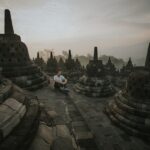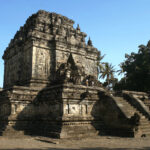Borobudur temple, also transcribed Barabudur (Indonesian: Candi Borobudur, Javanese: ꦕꦤ꧀ꦝꦶꦧꦫꦧꦸꦝꦸꦂ, romanized: Candhi Barabudhur) is a 9th-century Mahayana Buddhist temple in Magelang Regency, not far from the town of Muntilan, in Central Java, Indonesia. It is the world’s largest Buddhist temple. The temple consists of nine stacked platforms, six square and three circular, topped by a central dome. It has 2,672 relief panels and originally 504 Buddha statues. 72 Buddha statues surrounds the central dome, each seated inside a perforated stupa.
Mendut temple is a ninth-century Buddhist temple, located in Mendut village, Mungkid sub-district, Magelang Regency, Central Java, Indonesia. The temple is located about three kilometres east from Borobudur. Mendut, Borobudur and Pawon, all of which are Buddhist temples, are located in one straight line. There is a mutual religious relationship between the three temples, although the exact ritual process is unknown.
Prambanan temple (Indonesian: Candi Prambanan, Javanese: ꦫꦫꦗꦺꦴꦁꦒꦿꦁ, romanized: Rara Jonggrang) is a 9th-century Hindu temple compound in Yogyakarta, Indonesia. Dedicated to the Trimūrti, the expression of God as the Creator (Brahma), the Preserver (Vishnu) and the Destroyer (Shiva). The temple compound lies approximately 17 kilometres (11 mi) northeast of the city of Yogyakarta on the boundary between Central Java and Yogyakarta provinces.
Borobudur is the largest Buddhist temple in the world which has existed since the 9th century. The beauty of the building and the detailed carvings carved into the volcanic rocks will make anyone stunned. Mendut temple has been taking an important part within Buddhists all over the world especially on The Vesak Day between May and June. All the monks and participants walk from Mendut temple to Borobudur temple.
Prambanan temple is a perfect combination of the tour to give you more perspective on how Hinduism and Buddhism grew so well in Indonesia, leaving two remarkable sites to be witnessed by us today.











